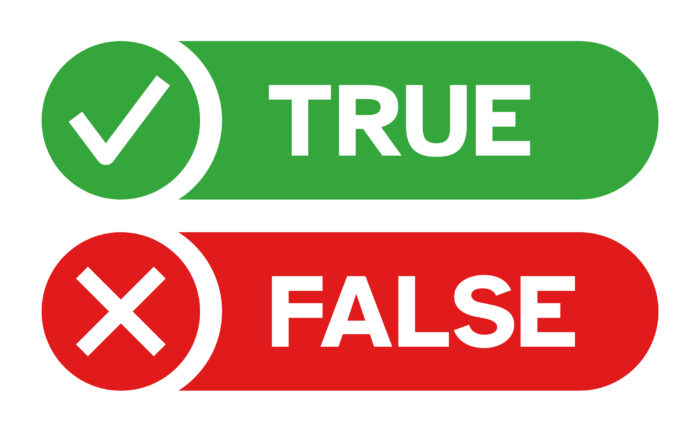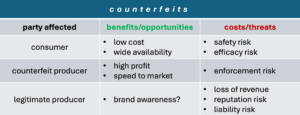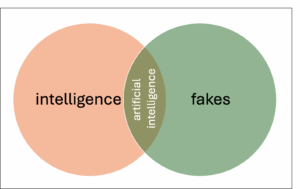
Analytics and Forecasting, Branding and Reputation, Knowledge Strategy, Security and Privacy
What’s wrong with fakes, anyway?
Artificial. Simulated. Copied. Ersatz. Imitation. False. Faux. Counterfeit. Knock-off. Synthetic. Sham. Illusory. Pseudo. Dummy. “As if.” Fake. We have many ways to describe a thing that is not what it seems to be.
I’ve long been fascinated by our collective fascination with the artificial. At one point, I was able to mold that curiosity into a business opportunity.
Eyes wide open
At one point during my main career as a strategic intelligence agent, I became aware that my client’s global brand packaged-good products were being sold through unauthorized trade channels, mainly the internet. And that many of these products were likely counterfeit or otherwise illegitimate.
My brief side career in the music business had instilled in me a healthy respect, verging on reverence, for intellectual property (IP) rights. And I saw these sales as direct attacks on my client’s IP and brand integrity. So I developed a novel approach to detecting such products, and guided a team that helped our client in bringing the activity under control.
It was later, when I tried to engage a global pharmaceutical company in a similar approach, that I met with a line of resistance I had not expected. Some of their senior leadership, like my first client, understood the concept of brand equity and how it could be attacked.
Others, however, saw counterfeits as just ‘another cost of doing business’ — an inevitability that they could do little to mitigate. As morally vacant as I found this attitude privately, I managed to refrain from lecturing my client to that end.
Devil’s advocacy
It’s an old maxim of strategic intelligence to see yourself as your rival sees you. So I decided to take the rhetorical tack of, What’s wrong with fakes, anyway? And what’s right with them? A little devil’s advocacy can sometimes work wonders, if only as a mind experiment.
For consumers, fake pharmaceuticals (like fake anything) hold several obvious advantages over the real deal. They’re cheaper and more widely available, often without a legitimate prescription. And they may contain traces of the real thing — or even be chemically identical to the real thing.
That said, consumers of fakes do not enjoy other benefits: the quality, safety, and effectiveness assurances that the real deal offers. Legitimate drugs are rigorously tested and manufactured in facilities that are inspected regularly.
Trade-offs
There are trade-offs, in other words, between the benefits and the risk of bad outcomes if one is using a fake drug. Bad outcomes for a drug include its not working as advertised, or far worse things like being poisoned. There’s typically little recourse if something does go wrong with a fake.
All those steps of development, testing, and quality assurance cost money to provide — which is recovered in the higher prices of the legitimate product.
Here’s a table that summarizes the value impact to the various parties in a counterfeit transaction:
As you see, the benefits and costs vary widely in nature and in potential impact.
Knock-offs
There’s also the related case of the knock-off, for example the fake LV handbag or Rolex watch, that no one pretends is real. This is relatively harmless. Though the manufacturer may have forfeited the sale of an item costing many times the cost of the fake, that’s likely not often the case.
And the buyer is not actually harmed by the fake product — only, perhaps, embarrassed if called out.
Fake intelligence?
I have years of applied experience in both fakes and in human intelligence and decision making. What of the hybrid, artificial intelligence? Which, to be clear, is simulated intelligence, as-if intelligence, and all the other synonyms listed earlier…including fake. What is the upside — and any downside — of using fake intelligence?
I define intelligence broadly as ‘the data-supported capability for making action-oriented decisions regarding one’s ecosystem.’
On the upside, the answers are much the same for intelligence as they are for drugs. Fake intelligence is inexpensive, widely available, and simple to acquire. Why bother doing research, working to capture an idea in writing, even going to college when a chatbot can do all these things faster, cheaper, and (arguably) better than you?
The downside is similar as well — the intelligence cannot be assured as either safe or effective. Though it may on occasion be either of these, it’s a risk you take. The first step in managing that risk is understanding it.
Safe and effective?
The meaning of ‘safe and effective’ is pretty clear when it comes to drugs. But what of intelligence — do these criteria still have meaning?
In general, the quality and quantity of intelligence should scale with the stakes of the decision to be made. If it’s a high-stakes, high-risk decision, like a business entering a new market, the intelligence should be proportionally intense.
If decisions are low-stakes and low-risk — writing a college paper, for example — then it’s unlikely to have material consequences and intelligence quality is not so immediately important. That said, “If you cheat on your homework, you’re only cheating yourself,” as they used to tell us — and there’s growing evidence that there are significant longer-term consequences to habitual ‘cognitive offloading.’
What you don’t know
An accurate assessment of stakes and risk is recommended when you have full awareness that a fake is being used. However, most often fakes are sold as the real deal, with the ‘ignorance tax’ on the user being the resulting outsized profit.
Auto parts are a natural target for physical world counterfeiters — they’re expensive and invisible to the average person. The Wall Street Journal recently reported that as many as seven recent car crashes in the US involved counterfeit airbags that failed to inflate properly, or even exploded, during a crash. Five people were killed.
The counterfeit airbags cost as little as $100 each and replace parts costing more than ten times that. The imitations look just like the real article.
Caveat emptor
No one willingly buys a car with dangerous air bags. And it’s not likely something you would detect unless and until you had a crash — when it’s obviously too late.
A fake airbag can kill you. But can artificial intelligence?
Stay tuned, we will learn more as robo-decisions edge their way toward physical world agency. But even now, decision processes can be compromised by GIGO — with reputational damage not far behind.
Ask Deloitte Australia. Their recent report to the Australian government on the subject of automating penalties for welfare fraud was found to contain numerous AI-generated errors — and is the focus of dismissive headlines worldwide. Was the resulting reputational damage worth saving a few dollars on actually doing the work the report purported to represent? For a firm in the assurance business, it’s hardly assuring.
Handbags or airbags?
Many of the arguments for genAI remind me of the arguments made by counterfeiters of products: the democratization of expertise — the world’s knowledge in a proverbial bottle, ready to tap into at negligible cost and effort. Is “as if” intelligence good enough, at least in some cases? Do truth and integrity just apply to the world of physical goods — or are they quaint, old-fashioned, non-adaptive ideas — even in the domain of intelligence?
Regarding intelligence, is ‘just good enough’ sometimes good enough? When — and when not? Why go to the focused work of creating words that engage, amuse, illuminate, challenge, and inspire — when a chatbot can spit up a grey wall of workmanlike words in seconds?
Does it matter? Are we dealing in fake handbags — or fake airbags?
When technology tempts us to needlessly cut corners, “Penny wise and pound foolish” is an old saw worth remembering. Consequences matter. While the benefits may be obvious, the costs are often far less so.
SOURCES:
WSJ article 9/22/25 https://www.wsj.com/business/autos/counterfeit-chinese-air-bag-parts-tied-to-five-deaths-a6436845?mod=Searchresults&pos=2&page=1
https://arstechnica.com/ai/2025/10/deloitte-will-refund-australian-government-for-ai-hallucination-filled-report/


Comments RSS Feed